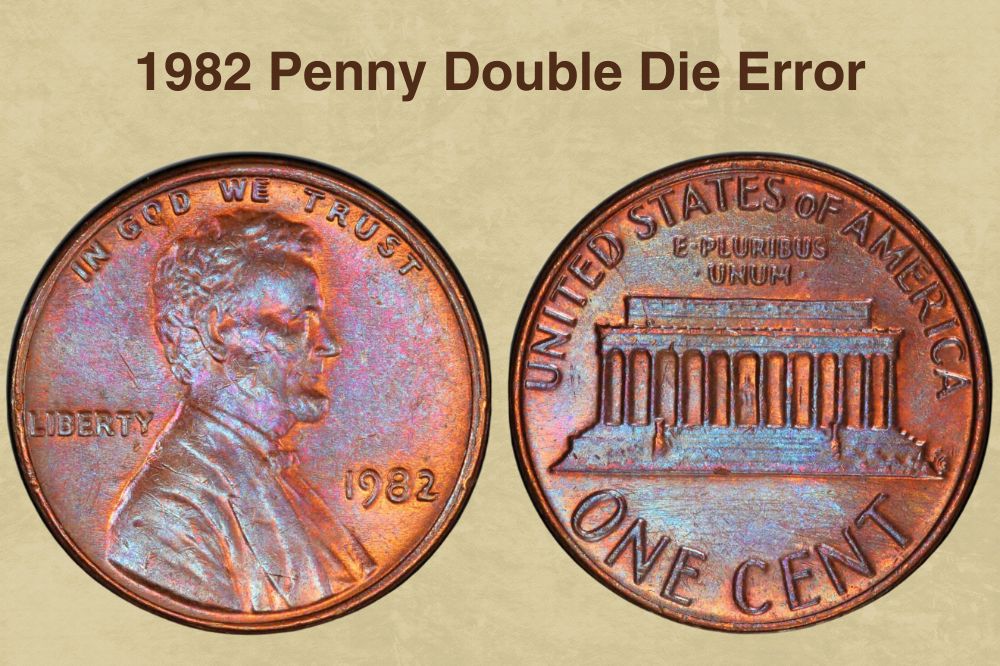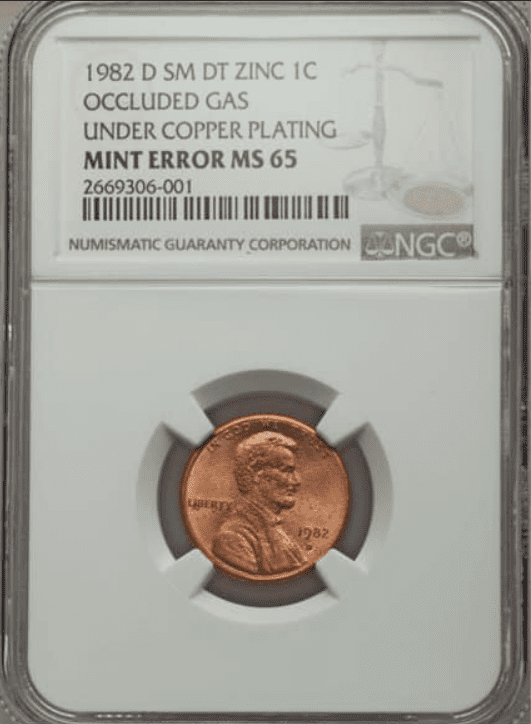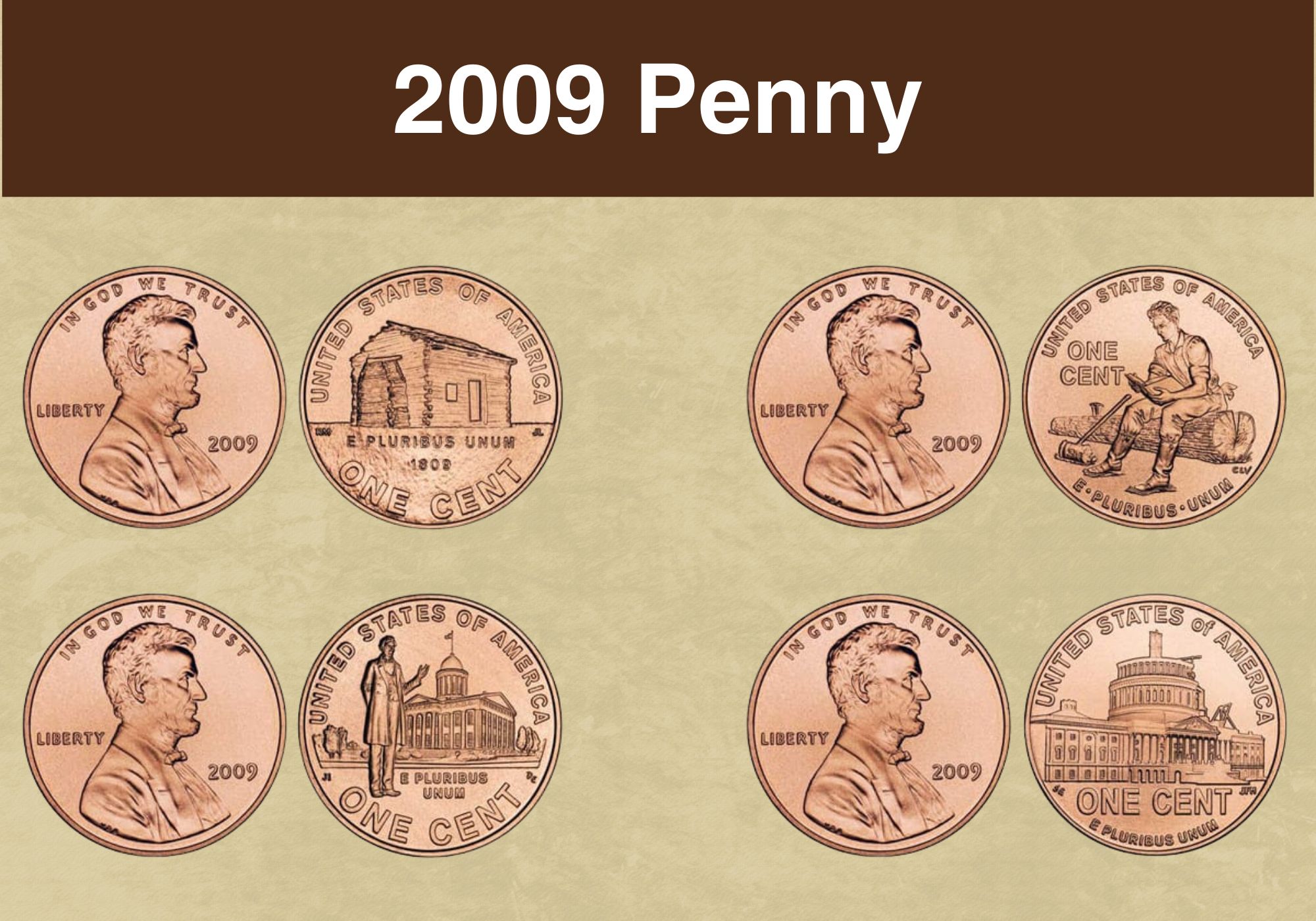
Coin Value Contents Table
Are you wondering if the 1982 penny in your coin collection is worth something?
Well, your 1982 penny may not make you a millionaire, but expect it to be worth more than its face value.
This amusing coin is not your typical Lincoln cent. It stands out because it marks the transition from traditional bronze composition to copper-plated zinc composition. Even better, the 1982 cent comes in more than three varieties.
Today, we’ll look at the design, background, and varieties of the 1982 penny to help you determine if you’ve got a rare piece in your possession.
1982 Penny Details
- Category: Lincoln Penny, Memorial Reverse
- Mint: Philadelphia, Denver, and San Francisco
- Obverse Designer: Victor D. Brenner
- Reverse Designer: Frank Gasparro
- Metal Composition:95% Copper and 5% tin and zinc, 99.2% Zinc and 0.008% copper
- Diameter: 19mm
- Weight:11g, 2.5g
- Edge: Plain
The Obverse
Originally, the U.S mint launched the Lincoln cent in 1909 to commemorate the 100th anniversary of Abraham Lincoln. The same applies to the 1982 Lincoln penny.
Designed by Victor D. Brenner, the obverse side of the 1982 penny depicts an image of the late President Abraham Lincoln facing right. In the image, Lincoln rocks a suit and a bow tie.
The words “IN GOD WE TRUST” fall above Lincoln’s head, whereas the inscription “LIBERTY” falls on the center-left. On the right side, just below Lincoln’s chest, lies the coin’s production date “1982”. But remember the date’s size in 1982 pennies varies based on the variety.
The Reverse
The beauty of the 1982 penny also extends to its reverse. Unlike earlier versions, the reverse side of the 1982 penny showcases the Lincoln Memorial instead of two ears of wheat.
In 1959, the US mint engaged Frank Gasparro to re-design Brenner’s wheat reverse. In response, Mr. Gasparro submitted a design featuring an image of Lincoln’s Memorial Hall.
Numismatics say Frank’s inspiration for the penny reverse came from ancient Greek coins, which show an image of a god on the obverse and his (or her) temple on the reverse.
Above the Lincoln Memorial lies the US motto “E. PLURIBUS. UNUM”, which means “one from many”. The term “UNITED STATES OF AMERICA” arcs on top, honoring America’s heritage. As for the denomination “ONE CENT”, it falls at the bottom, below the Memorial.
Additional Details
The first generation of the 1982 pennies has a composition of 95% copper and 5% zinc and tin. They weigh 3.11 grams and have a diameter of 19 millimeters.
Conversely, the second generation has 95% zinc and 5% tin and copper. Because of this composition, these 1982 pennies weigh less at 2.5 grams. However, they still maintain the same diameter of 19 millimeters.
Both generations of coins have a smooth, plain edge. Also, they were minted in three centers, including Philadelphia (no mint mark), Denver (“D” mint mark), and San Francisco (“S” mint mark).
1982 Penny Value Chart |
||||
| Mint Mark | Variety | Circulated | Mint State (MS64) | Mint State (MS 67) |
| 1982 “no mint mark” penny value | Small Date (Copper) | $0.04 – $0.50 | $2.50 – $15 | $600-$1000 |
| Large Date (Copper) | $0.04 – $0.50 | $1 – $10 | $75-$125 | |
| Small Date
(Zinc-coated steel) |
$0.04 – $0.50 | $1 – $5 | $75-$125 | |
| Large Date (Zinc-coated steel) | $0.04 – $0.50 | $1 – $5 | $49-$81 | |
| 1982 “D” Penny Value | Large Date (Copper) | $0.04 – $0.40 | $1 – $5 | $7.50 – $80 |
| Small Date (Zinc-coated steel) | $0.04 – $0.50 | $1 – $10 | $7.50 – $40 | |
| Large Date (Zinc-coated steel) | $0.04 – $0.10 | $2.50 – $7.50 | $35 | |
| 1982 “S” Penny Value | Proof 1982 Penny (Zinc Coated) | – | $2 | $6.50 |
1982 Penny Grading
Understanding your 1982 penny’s grade makes it easy to determine its worth. Oftentimes, Lincoln cent’s grade varies depending on their condition and color. Check the YouTube video below to learn about the 1982 Lincoln penny grading.
| # | Grade |
|---|---|
| 1 | Basal State-1 |
| 2 | Fair |
| 3 | Very Fair |
| 4, 5, 6 | Good |
| 7, 8, 10 | Very Good |
| 12, 15 | Fine |
| 20, 30 | Very Fine |
| 40 | Extremely Fine |
| 50 | About Uncirculated |
| 60 | Mint State |
| 65 | Mint State |
| 70 | Mint State |
Please check our grading guides to know your coin scale, It’s the necessary step to know the exact value of your coin.
Check out now: How to Grade Lincoln Wheat Penny?
1982 Penny Value and Varieties Guide
Most US coins usually have 2 to 3 variants. But in 1982, the government struck eight varieties of the penny. Seven variants entered circulation, and one remained as a proof series. Below, we will discuss each variety, including its composition and value.
1982 no mint mark Penny Value
- Type: Lincoln Cent
- Edge: Plain
- Mint Mark: No Mint Mark
- Place of Minting: Philadelphia
- Year of Minting: 1982
- Face Value: 01 USD
- $ Price: $0.05 – $375
- Mintage: 10, 712, 525,000
In 1982, the mint in Philadelphia produced over 10.7 billion Lincoln cents. However, these pennies vary in metal composition and size of the date.
First, let’s look at the metal composition. The first batch of pennies struck by the Philadelphia mint in 1982 comprised 95% copper and 5% tin and zinc. Other sources refer to this metal composition as bronze or brass.
Later in the year, the minting facility transitioned to copper-plated zinc (or zinc-coated steel) composition. However, the mint had to re-work the coin’s obverse master hub midway through 1982. The new hub featured a smaller date logo than in the previous design.
This minor change brought about different combinations of date size and composition for the 1982 cent, including:
-
1982 Large Date Bronze Penny
The 1982 “no mint mark” with bronze/copper composition and large date can cost an average of $0.05 in circulated condition. In an uncirculated state, the coin’s value can range from $1 to $10. But pieces in higher grades – MS67 and above–can sell for as much as $1,495.
-
1982 Small Date Bronze Penny
The small date variant is super rare and highly sought-after by coin collectors. Despite the huge mintage number, these pieces are hard to find in circulated and uncirculated conditions. That explains why they often fetch a higher price.
Besides the condition, the color of the copper coin can also affect its value. 1982 pennies that have retained their original red luster are more valuable than pieces with brown or red-brown shades.
In circulated condition, a 1982 “no mint mark” small date penny with a brown tone can sell for approximately $2.50. But those with red toning can cost $15 or more.
In mint state, coins with a rich red or violet luster can sell for thousands of dollars. In fact, one specimen graded at MS67+ sold for a whopping $9,987.50 in 2014.
-
1982 Large Date Copper-plated Zinc Penny
1982 large date, copper-plated zinc pennies from Philadelphia mint are super common in circulated and mint state conditions. They are also less valuable than their bronze counterparts.
Circulated coins can cost anywhere from $0.04 to $0.50. In an uncirculated state, depending on the color, these pennies can fetch between $1 and $5. In grade MS67, the value of a small date zinc penny ranges from $75 to $2,401.
-
1982 Small Date Copper-plated Zinc Penny
Next, we have a 1982 small date, copper-plated zinc penny. Like its large date sister, it’s cheap and readily available in circulated and mint grades. However, pennies in pristine condition and higher grades, like MS69, can sell for as much as $15,600.
1982 “D” Penny Value
- Type: Lincoln Cent
- Edge: Plain
- Mint Mark: D
- Place of Minting: Denver
- Year of Minting: 1982
- Face Value: 01 USD
- $ Price: $0.05 – $375
- Mintage: 6,012,979,368
The Denver mint struck more than 6 million Lincoln pennies in 1982. Like the Philadelphia mint, this minting facility produced both bronze and copper-plated zinc coins.
-
1982-D Bronze Penny
Before October 21, 1982, the minting center in Denver struck only bronze Lincoln cents. All the 1982-D cents featured a large date. However, some coin collectors have discovered a few 1982-D small date bronze pennies. One such collector is Paul Malone from Minnesota, who found a specimen worth $18,800.
But what is the value of a 1982-D large date bronze coin?
This coin in circulated conditions is valued from $0.04 to $0.50. In an uncirculated state, the value of the penny could range from $1 to $5. Mint state bronze pieces with their original red luster can sell for upwards of $80 to $445.
-
1982-D Zinc-Coated Steel Penny
After transitioning to copper-plated zinc, the Denver mint cleared away all the brass coins and planchets and began producing zinc cents.
But the minting process was not without setbacks. For instance, the quality of strikes was reduced. As a result, the mint had to adjust the penny’s observe details, including the date to increase production speed. This resulted in a small date copper-plated zinc cent.
Like in bronze pennies, the small date subtypes have a higher value than their large date counterparts. In mint state 64, a 1982-D small date zinc penny sells for approximately $10, depending on its condition. Contrary, a 1982-D large date zinc date penny in the same grade costs between $2.50 to $7.50.
In grade MS67+, a large date cent can sell for upwards of $1,880, while a small date cent can fetch up to $18,000.
1982 “S” Penny Value Proof
- Type: Lincoln Cent
- Edge: Plain
- Mint Mark: S
- Place of Minting: San Francisco
- Year of Minting: 1982
- Face Value: 01 USD
- $ Price: $0.05 – $80
- Mintage: 3,857,479
The minting center in San Francisco minted over 3.8 million pennies with the “S” mint mark. But these pieces were designed specifically for coin collectors and investors. That means they never entered circulation.
Unlike the other center, the San Francisco batch had no small or large date subtypes. They were all made of a new metal composition: copper-plated zinc.
However, the mint experienced an issue during mintage. The zinc core breached the copper plating under the repeated impression given to proof pennies.
Fortunately, the minting center figured out a solution to the problem. They furnished the planchet to create proof coins with a second layer of copper plating.
Another interesting fact is that the facility struck 1,587,245 zinc coins, which were released to the public in 1982. But these Lincoln cents bear no mintmarks.
Due to the low mintage, the 1982–S proof pennies are rare. But they don’t fetch high prices in the market as you might have thought.
At PR62, expect these coins to cost at least $2. Even in higher grades, their value doesn’t increase as much, and they might fetch you around $6.50. But in 2013, a rare 1982-S cent with a deep Cameo, graded at PR70 sold for $7,080.
Also read: 12 Most Valuable Lincoln Penny Worth Money
1982 Penny History
In the years before 1982, most people loved copper pennies because they could maintain their beauty and quality for a long time. But something happened in 1982 that forever changed the US coinage.
It all starts in 1973 when the price of copper increased to a point where melting the Lincoln cent proved more profitable. Luckily, this never came to pass. However, changes in copper prices forced the U.S mint to experiment with alternatives to the traditional composition: 95% copper and 5% zinc.
One alternative that showed so much promise is aluminum. As a fact, the mint struck about 1.5 million aluminum Lincoln cents, all dated 1974. They minted these units anticipating that Congress will approve them. Unfortunately, their plan never went through and most aluminum coins got destroyed.
But in 1979, one pound of copper surpassed the one-dollar limit, forcing congress to act. Finally, in 1981, the mint changed the cent’s composition from 95% copper to just 0.04% copper bonded to a 99.2% zinc core.
On January 7, 1982, the production of the copper-plated zinc pennies began in West Point Mint before the Philadelphia center took over.
Coins from the West Point mint bear no mint mark, therefore they are indistinguishable from those produced in Philadelphia.
The Denver mint continued to produce bronze Lincoln pennies until the transition day: October 21, 1982. About 6 billion pieces got produced in this minting facility.
As for the San Francisco minting center, it struck over 1.5 million regular strike units (they bear no mintmarks) and more than 3 million proof 1982 pennies.
The transition from bronze cents to copper-plated zinc cents also gave rise to several varieties of the 1982 penny, as highlighted above.
Also read: 13 Most Valuable Wheat Penny Worth Money
Rare 1982 Penny Error List
It’s no surprise to find 1982 pennies with errors, considering their high mintage. Some mistakes make them extremely rare and increase their value significantly. In this section, we have highlighted the most common 1982 penny errors.
1. 1982 Penny Value Double Die Error
Perhaps one popular error in 1982 pennies is the Double die error. It happens when a worn-out coin die stamps a second image of the design on a blank planchet.
The double die error is common in 1982 “no mint mark” Lincoln cents. If you have such a coin, look for doubling on the obverse and reverse sides, especially on the lettering. Some Denver pieces from 1982 might also display some doubling, particularly on Lincoln’s ear.
1982 pennies with double die errors can be worth anywhere from $150 to $200, depending on their grade.
2. 1982 Penny Value Occluded Gas Bubbles Under Plating Error
Another error worth highlighting is the Occluded gas bubbles under plating error. It occurs when high temperatures generated by striking the blank planchet cause air pockets to form below the penny’s surface.
A 1982-D found with occluded gas bubbles discovered in 2016 sold for $39.
3. 1982 Penny Value Struck Off-Center Error

Last, we have another highly sought-after coin error by collectors–the off-center error. As the name suggests, specimens with this error have their design struck off-center, leaving a big blank area.
These coins can fetch between $90 to $120, depending on the degree of deviation and the color and condition of the coin.
Also read: 11 Most Valuable Wheat Penny Errors
Where to Sell Your 1982 Penny?
Now that you know the value of your coins, do you know where to sell those coins online easily? Don’t worry, I’ve compiled a list of these sites, including their introduction, pros, and cons.
Check out now: Best Places To Sell Coins Online (Pros & Cons)
1982 Penny FAQs
Is the 1982-D small date bronze penny a variety or error?
Most people might argue the 1982-D small date bronze penny is the eighth variation of the 1982 penny. However, grading experts consider it a mint error because it was stuck in a leftover planchet and accidentally entered circulation.
How can you identify the small and large date of 1982 pennies?
1982 small and large date Lincoln cents have a few differences. For example, all the numbers in the date (1982) align at the bottom in a large date subtype. But small date variety, the number seems misaligned, with the “8” looking a bit raised.
Another way to differentiate the two varieties is to look at the numeral “2”. In the small date penny, the number “2” curves all down before getting to the flat bottom. In the large date coin, the number “2” has no curves. It curves a little at the top and goes all the way down to the flat bottom.














WHAT IS THE WEIGHT DIFFERENCE ON THE 1982 PENNY BETWEEN COPPER AND ZINC
Hi 3.11 for the copper brass! Pennies 2.5 for the zinc ( after 1982)
What is the weight difference between a 1982 copper,zinc & bronze?
The bronze 1982 d penny is 3.1 and the copper zinc penny is 2.5
What are the 1930 S wheat penny errors.
I have a 1982 d small date copper penny.how much is this coin going for today? I also I have a 1980 copper penny with a unusual error on the reverse.the memorial is doubled as well as kriscrossed to each other.i haven’t found anything close to this coin.what would be the value of something like this.you can see the error with the naked eye.
I’m surprised that no one has fund this coin.for 44 yrs .wow it’s very unusual. It’s got to be worth a lot.i would think.any one with info on this coin please let me know.thank you.
I have a 1982 no mint mark,it has many errors such as the D in UNITED has what looks like a copper pipe coming out of the top right of the D and the E looks strange also the date 8 and 2,the 8 has the holes and the 2’s tail end looks like a upward point